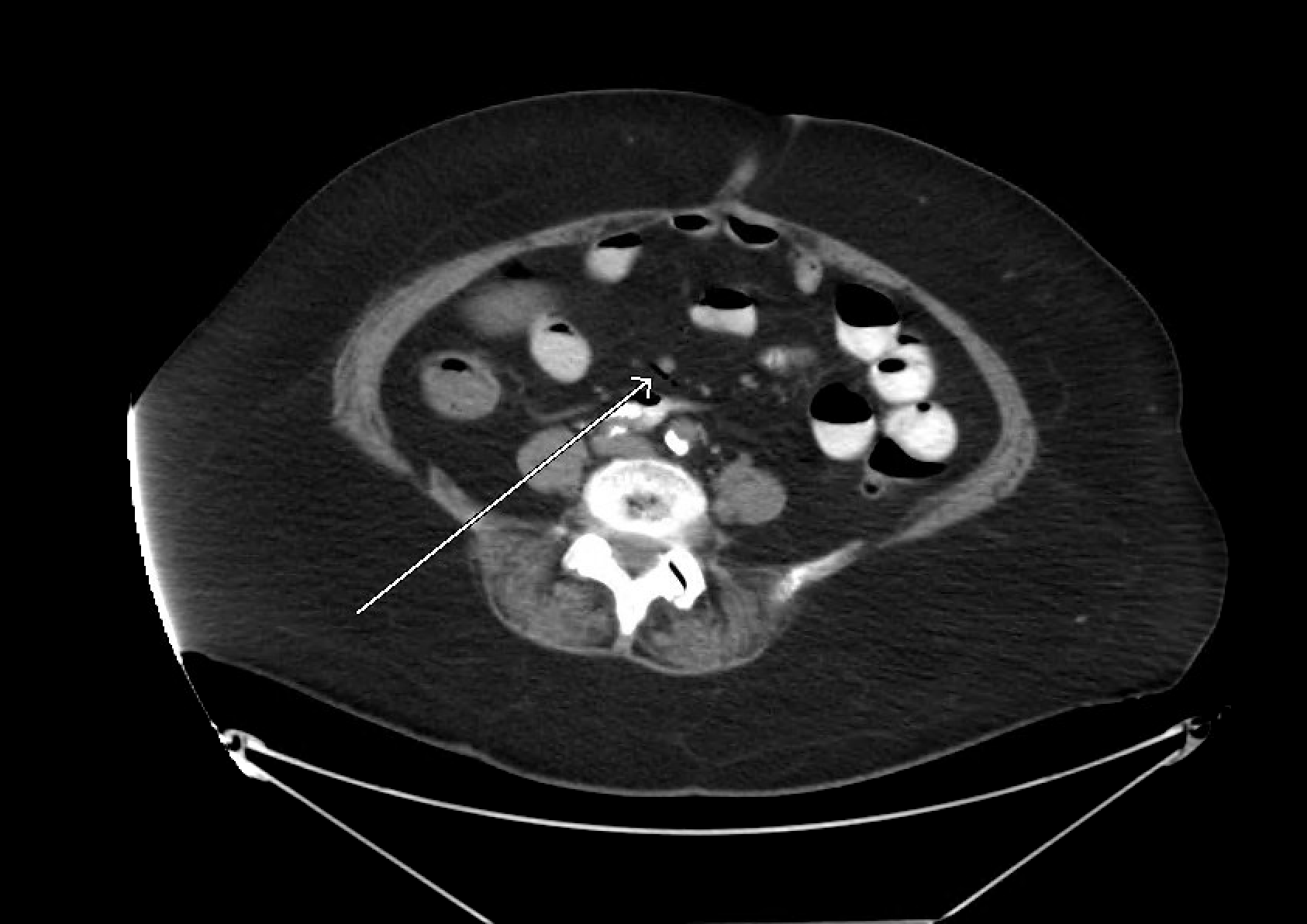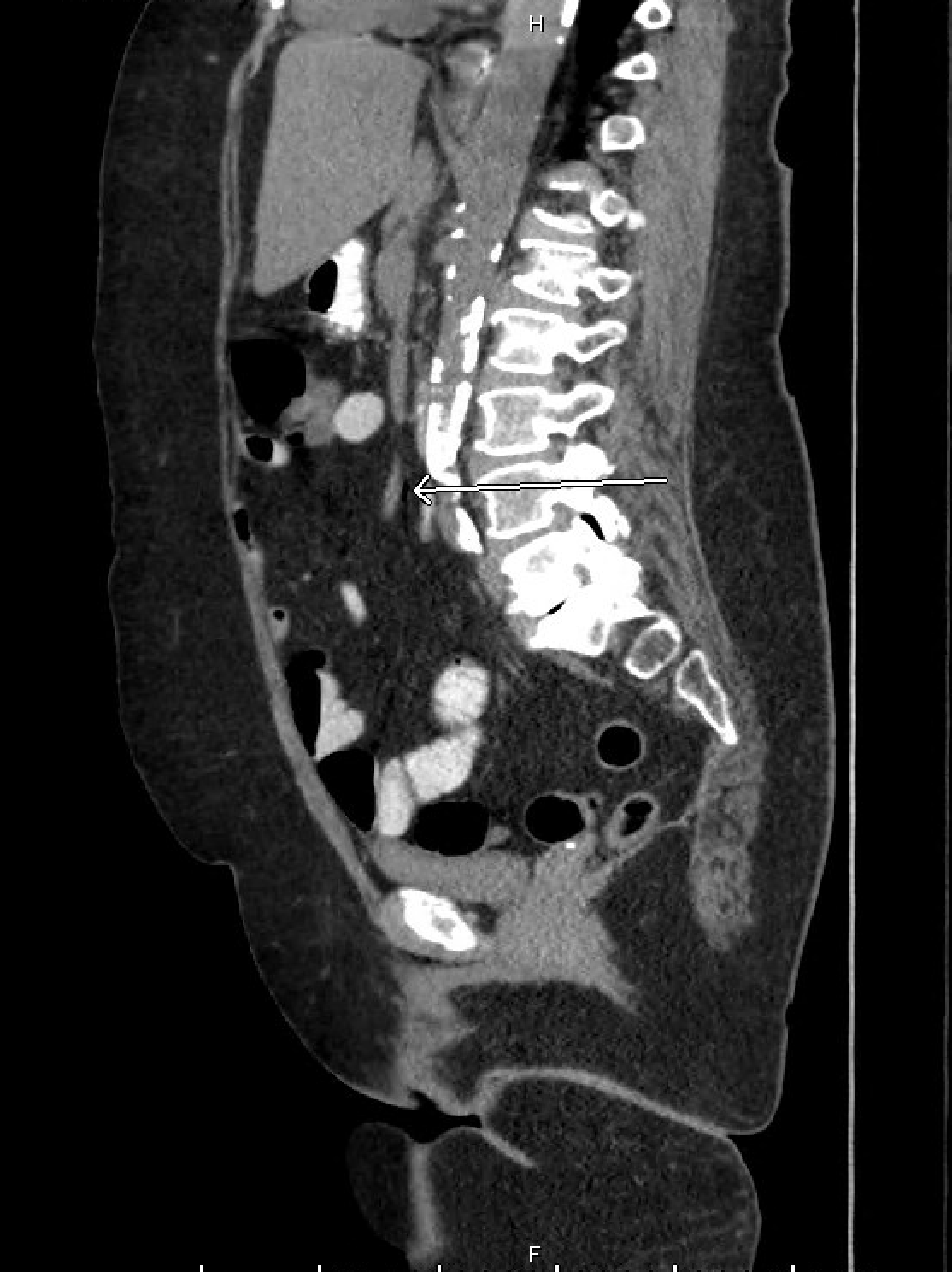Sunday Poster Session
Category: Small Intestine
P1980 - Gas Solely in the Superior Mesenteric Artery: An Uncommon CT Finding of Severe Acute Mesenteric Ischemia?
Sunday, October 26, 2025
3:30 PM - 7:00 PM PDT
Location: Exhibit Hall
- PB
Pinky Bai, MD (she/her/hers)
Howard University Hospital
Washington, DC
Presenting Author(s)
Pinky Bai, MD1, Ali Chand, MD1, Amira Soubiane, MD1, Nakul Ganju, MD2, Aasta Kumari, MD3, Lamiaa Rougui, MD1, Mukarram Jamat Ali, MD1
1Howard University Hospital, Washington, DC; 2Department of Medicine, Howard University Hospital, Washington, DC; 3North Central Bronx Hospital, New York, NY
Introduction: Acute mesenteric ischemia (AMI) is a fatal condition which is caused by sudden disruption of blood flow to the intestines. Although, it only accounts for < 0.2% cases among surgical admissions but carries a high mortality rate of 60-80%. Diagnosis is usually challenging due to vague symptoms on presentation. Contrast-enhanced Computed Tomography (CT) is the gold standard for diagnosis. CT findings include bowel wall thickening or thinning, dilated fluid-filled bowel loops, pneumatosis, and portal venous gas. Isolated presence of gas in superior mesenteric artery (SMA) is exceedingly rarely. We present a rare case of AMI in which CT without contrast showed gas only in SMA without a trace of in the portal vein and superior mesenteric vein.
Case Description/
Methods: A 74-year-old female with a history of hypertension, type 2 diabetes mellitus, and coronary artery disease post-CABG who presented to ED with diffuse abdominal pain, nausea, vomiting, diarrhea, increased thirst, and polyuria for 3 days. Vitals were notable for mildly elevated BP and tachycardia. Abdominal examination demonstrated diffuse tenderness with no signs of peritonitis. Laboratory results revealed a glucose of 530 mg/dL, anion gap metabolic acidosis with HCO3 17 mEq/mL and anion gap 34, leukocytosis 15x109/L, elevated ketones 6.6 mg/dL and lactic acid 7 mg/dL. Patient was treated for diabetic ketoacidosis (DKA) and sepsis. However, due to severe abdominal pain, non-contrast CT abdomen was obtained. It showed incidental findings of air within the mesenteric branches of the SMA. There was mildly dilated proximal colon with air-fluid levels suggestive of ileus, but no obstruction, colitis, free fluid, or pneumoperitoneum. Given the finding of air within SMA, patient underwent emergent diagnostic laparoscopy which revealed ischemic bowel with near-total necrosis of the small and large intestine in the SMA distribution. The condition was deemed incompatible with life and it was decided not to excise the necrotic bowel. Patient died the following day due to multiple organ failure.
Discussion: AMI is rare but fatal without early recognition and timely intervention. CT findings of the presence of gas in the porto-mesenteric venous system is common in AMI but the presence of gas only in SMA is extremely rare. Physicians should be cognizant of the unusual association between gas in the SMA territory and AMI, even in the absence of porto-venous involvement, for prompt diagnosis and urgent intervention.

Figure: Sagittal non-contrast abdominal CT showing gas within the superior mesenteric artery (SMA) (arrow)

Figure: Axial non-contrast abdominal CT demonstrating intraluminal gas in a branch of the superior mesenteric artery (arrow). Absence of portal venous or mesenteric venous gas supports an isolated arterial origin.
Disclosures:
Pinky Bai indicated no relevant financial relationships.
Ali Chand indicated no relevant financial relationships.
Amira Soubiane indicated no relevant financial relationships.
Nakul Ganju indicated no relevant financial relationships.
Aasta Kumari indicated no relevant financial relationships.
Lamiaa Rougui indicated no relevant financial relationships.
Mukarram Jamat Ali indicated no relevant financial relationships.
Pinky Bai, MD1, Ali Chand, MD1, Amira Soubiane, MD1, Nakul Ganju, MD2, Aasta Kumari, MD3, Lamiaa Rougui, MD1, Mukarram Jamat Ali, MD1. P1980 - Gas Solely in the Superior Mesenteric Artery: An Uncommon CT Finding of Severe Acute Mesenteric Ischemia?, ACG 2025 Annual Scientific Meeting Abstracts. Phoenix, AZ: American College of Gastroenterology.
1Howard University Hospital, Washington, DC; 2Department of Medicine, Howard University Hospital, Washington, DC; 3North Central Bronx Hospital, New York, NY
Introduction: Acute mesenteric ischemia (AMI) is a fatal condition which is caused by sudden disruption of blood flow to the intestines. Although, it only accounts for < 0.2% cases among surgical admissions but carries a high mortality rate of 60-80%. Diagnosis is usually challenging due to vague symptoms on presentation. Contrast-enhanced Computed Tomography (CT) is the gold standard for diagnosis. CT findings include bowel wall thickening or thinning, dilated fluid-filled bowel loops, pneumatosis, and portal venous gas. Isolated presence of gas in superior mesenteric artery (SMA) is exceedingly rarely. We present a rare case of AMI in which CT without contrast showed gas only in SMA without a trace of in the portal vein and superior mesenteric vein.
Case Description/
Methods: A 74-year-old female with a history of hypertension, type 2 diabetes mellitus, and coronary artery disease post-CABG who presented to ED with diffuse abdominal pain, nausea, vomiting, diarrhea, increased thirst, and polyuria for 3 days. Vitals were notable for mildly elevated BP and tachycardia. Abdominal examination demonstrated diffuse tenderness with no signs of peritonitis. Laboratory results revealed a glucose of 530 mg/dL, anion gap metabolic acidosis with HCO3 17 mEq/mL and anion gap 34, leukocytosis 15x109/L, elevated ketones 6.6 mg/dL and lactic acid 7 mg/dL. Patient was treated for diabetic ketoacidosis (DKA) and sepsis. However, due to severe abdominal pain, non-contrast CT abdomen was obtained. It showed incidental findings of air within the mesenteric branches of the SMA. There was mildly dilated proximal colon with air-fluid levels suggestive of ileus, but no obstruction, colitis, free fluid, or pneumoperitoneum. Given the finding of air within SMA, patient underwent emergent diagnostic laparoscopy which revealed ischemic bowel with near-total necrosis of the small and large intestine in the SMA distribution. The condition was deemed incompatible with life and it was decided not to excise the necrotic bowel. Patient died the following day due to multiple organ failure.
Discussion: AMI is rare but fatal without early recognition and timely intervention. CT findings of the presence of gas in the porto-mesenteric venous system is common in AMI but the presence of gas only in SMA is extremely rare. Physicians should be cognizant of the unusual association between gas in the SMA territory and AMI, even in the absence of porto-venous involvement, for prompt diagnosis and urgent intervention.

Figure: Sagittal non-contrast abdominal CT showing gas within the superior mesenteric artery (SMA) (arrow)

Figure: Axial non-contrast abdominal CT demonstrating intraluminal gas in a branch of the superior mesenteric artery (arrow). Absence of portal venous or mesenteric venous gas supports an isolated arterial origin.
Disclosures:
Pinky Bai indicated no relevant financial relationships.
Ali Chand indicated no relevant financial relationships.
Amira Soubiane indicated no relevant financial relationships.
Nakul Ganju indicated no relevant financial relationships.
Aasta Kumari indicated no relevant financial relationships.
Lamiaa Rougui indicated no relevant financial relationships.
Mukarram Jamat Ali indicated no relevant financial relationships.
Pinky Bai, MD1, Ali Chand, MD1, Amira Soubiane, MD1, Nakul Ganju, MD2, Aasta Kumari, MD3, Lamiaa Rougui, MD1, Mukarram Jamat Ali, MD1. P1980 - Gas Solely in the Superior Mesenteric Artery: An Uncommon CT Finding of Severe Acute Mesenteric Ischemia?, ACG 2025 Annual Scientific Meeting Abstracts. Phoenix, AZ: American College of Gastroenterology.
